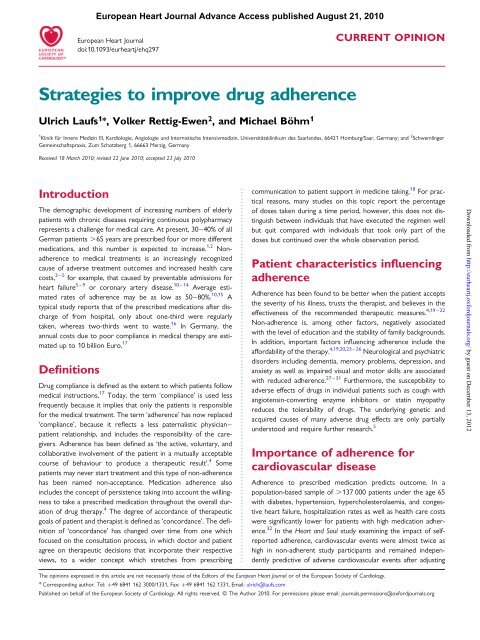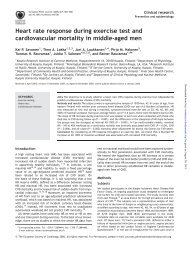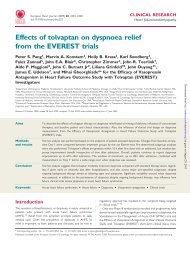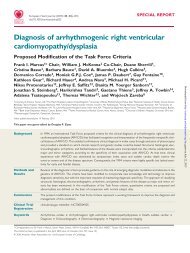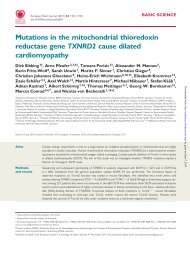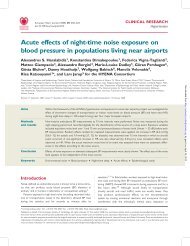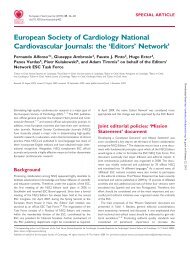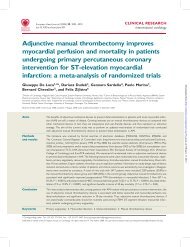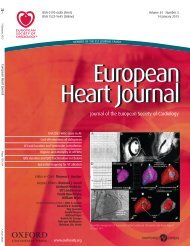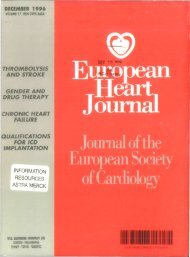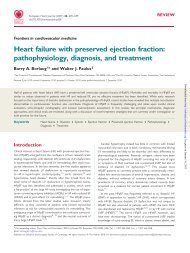'healthy adherer' phenomenon - European Heart Journal
'healthy adherer' phenomenon - European Heart Journal
'healthy adherer' phenomenon - European Heart Journal
Create successful ePaper yourself
Turn your PDF publications into a flip-book with our unique Google optimized e-Paper software.
Strategies to improve drug adherence<br />
Ulrich Laufs 1 *, Volker Rettig-Ewen 2 , and Michael Böhm 1<br />
CURRENT OPINION<br />
1 Klinik für Innere Medizin III, Kardiologie, Angiologie und Internistische Intensivmedizin, Universitätsklinikum des Saarlandes, 66421 Homburg/Saar, Germany; and 2 Schwemlinger<br />
Gemeinschaftspraxis, Zum Schotzberg 1, 66663 Merzig, Germany<br />
Received 18 March 2010; revised 22 June 2010; accepted 23 July 2010<br />
Introduction<br />
The demographic development of increasing numbers of elderly<br />
patients with chronic diseases requiring continuous polypharmacy<br />
represents a challenge for medical care. At present, 30–40% of all<br />
German patients .65 years are prescribed four or more different<br />
medications, and this number is expected to increase. 1,2 Nonadherence<br />
to medical treatments is an increasingly recognized<br />
cause of adverse treatment outcomes and increased health care<br />
costs, 3 – 5 for example, that caused by preventable admissions for<br />
heart failure 5 – 9 or coronary artery disease. 10 – 14 Average estimated<br />
rates of adherence may be as low as 50–80%. 10,15 A<br />
typical study reports that of the prescribed medications after discharge<br />
of from hospital, only about one-third were regularly<br />
taken, whereas two-thirds went to waste. 16 In Germany, the<br />
annual costs due to poor compliance in medical therapy are estimated<br />
up to 10 billion Euro. 17<br />
Definitions<br />
<strong>European</strong> <strong>Heart</strong> <strong>Journal</strong> Advance Access published August 21, 2010<br />
<strong>European</strong> <strong>Heart</strong> <strong>Journal</strong><br />
doi:10.1093/eurheartj/ehq297<br />
Drug compliance is defined as the extent to which patients follow<br />
medical instructions. 17 Today, the term ‘compliance’ is used less<br />
frequently because it implies that only the patients is responsible<br />
for the medical treatment. The term ‘adherence’ has now replaced<br />
‘compliance’, because it reflects a less paternalistic physician–<br />
patient relationship, and includes the responsibility of the caregivers.<br />
Adherence has been defined as ‘the active, voluntary, and<br />
collaborative involvement of the patient in a mutually acceptable<br />
course of behaviour to produce a therapeutic result’. 4 Some<br />
patients may never start treatment and this type of non-adherence<br />
has been named non-acceptance. Medication adherence also<br />
includes the concept of persistence taking into account the willingness<br />
to take a prescribed medication throughout the overall duration<br />
of drug therapy. 4 The degree of accordance of therapeutic<br />
goals of patient and therapist is defined as ‘concordance’. The definition<br />
of ‘concordance’ has changed over time from one which<br />
focused on the consultation process, in which doctor and patient<br />
agree on therapeutic decisions that incorporate their respective<br />
views, to a wider concept which stretches from prescribing<br />
communication to patient support in medicine taking. 18 For practical<br />
reasons, many studies on this topic report the percentage<br />
of doses taken during a time period, however, this does not distinguish<br />
between individuals that have executed the regimen well<br />
but quit compared with individuals that took only part of the<br />
doses but continued over the whole observation period.<br />
Patient characteristics influencing<br />
adherence<br />
Adherence has been found to be better when the patient accepts<br />
the severity of his illness, trusts the therapist, and believes in the<br />
4,19 – 22<br />
effectiveness of the recommended therapeutic measures.<br />
Non-adherence is, among other factors, negatively associated<br />
with the level of education and the stability of family backgrounds.<br />
In addition, important factors influencing adherence include the<br />
affordability of the therapy. 4,19,20,23 – 26 Neurological and psychiatric<br />
disorders including dementia, memory problems, depression, and<br />
anxiety as well as impaired visual and motor skills are associated<br />
with reduced adherence. 27 – 31 Furthermore, the susceptibility to<br />
adverse effects of drugs in individual patients such as cough with<br />
angiotensin-converting enzyme inhibitors or statin myopathy<br />
reduces the tolerability of drugs. The underlying genetic and<br />
acquired causes of many adverse drug effects are only partially<br />
understood and require further research. 5<br />
Importance of adherence for<br />
cardiovascular disease<br />
Adherence to prescribed medication predicts outcome. In a<br />
population-based sample of .137 000 patients under the age 65<br />
with diabetes, hypertension, hypercholesterolaemia, and congestive<br />
heart failure, hospitalization rates as well as health care costs<br />
were significantly lower for patients with high medication adherence.<br />
32 In the <strong>Heart</strong> and Soul study examining the impact of selfreported<br />
adherence, cardiovascular events were almost twice as<br />
high in non-adherent study participants and remained independently<br />
predictive of adverse cardiovascular events after adjusting<br />
The opinions expressed in this article are not necessarily those of the Editors of the <strong>European</strong> <strong>Heart</strong> <strong>Journal</strong> or of the <strong>European</strong> Society of Cardiology.<br />
* Corresponding author. Tel: +49 6841 162 3000/1331, Fax: +49 6841 162 1331, Email: ulrich@laufs.com<br />
Published on behalf of the <strong>European</strong> Society of Cardiology. All rights reserved. & The Author 2010. For permissions please email: journals.permissions@oxfordjournals.org<br />
Downloaded from<br />
http://eurheartj.oxfordjournals.org/ by guest on December 13, 2012
Page 2 of 6<br />
for baseline disease severity and known risk factors. 10 In .54 000<br />
new statin users in the Netherlands, adherence to statin treatment<br />
for at least 2 years was associated with a 30% reduction in acute<br />
myocardial infarction with even better results in patients taking<br />
higher doses. 12 Similar results were obtained in a study examining<br />
the effects of medication adherence on long-term mortality in a<br />
cohort of .31 000 Canadian AMI survivors. 13 In a retrospective<br />
cohort study of .229 000 patients in Israel, the extent of<br />
reduction of all-cause mortality was directly associated with adherence<br />
to statin intake (relative Hazard Ratio 0.53 for patients with<br />
≥90% of treatment days covered by statins compared with<br />
,10%). 11 Another example of the importance of adherence<br />
outcome is an analysis of the CHARM study that assessed the<br />
effects of treatment with the angiotensin receptor blocker candesartan<br />
in 7600 patients with chronic heart failure. 5 Good adherence<br />
was defined as an intake of .80% of the prescribed dose<br />
and correlated with a lower risk of death. The extent of risk<br />
reduction associated with good adherence was markedly greater<br />
than the risk reduction conferred by the study drug candesartan<br />
itself. Adherence to placebo resulted in a similar reduction of mortality<br />
compared with good adherence to candesartan (hazard ratio<br />
0.66 in the verum group and 0.53 in the placebo group). 5<br />
The ‘healthy adherer’<br />
<strong>phenomenon</strong><br />
Good adherence to both placebo as well as to drug treatments is<br />
associated with reduced mortality. 33 This observation supports the<br />
concept of the ‘healthy adherer’ effect, whereby adherence to drug<br />
treatment represents a surrogate marker for overall healthy behaviour.<br />
The hypothesis is that people who adhere to healthy lifestyles<br />
also tend to take better care of themselves by greater adherence<br />
to prescribed treatments. Indeed, in a recent study on the correlation<br />
between statin adherence and the risk of non-medication<br />
related accidents and diseases, it was shown that good statin<br />
adherence was associated with a lower probability of having<br />
motor vehicle accidents or workplace accidents as well as suffering<br />
from diseases unrelated to statin use. The lower probability of<br />
having accidents was related to a more health-conscious lifestyle,<br />
such as using screening services. 34 These observations show that<br />
poor adherence identifies individuals at increased risk. The challenge<br />
is to find a comprehensive approach to enhance the<br />
factors underlying the ‘healthy adherer’ <strong>phenomenon</strong>.<br />
Importance of medication<br />
adherence for drug safety<br />
The problems of poor medication adherence are not limited to<br />
drug discontinuation but include inappropriate use of drugs. 35,36<br />
Adverse events of medication have been observed in ≏5% of all<br />
treated patients. They are the cause of 3–5% of all hospital admissions.<br />
37 – 39 In the majority of cases adverse drug reactions are<br />
associated with incorrect drug use. 37,40 As much as two-thirds of<br />
adverse drug events following hospital discharge have been estimated<br />
to be preventable with an improved management of adherence<br />
and better monitoring: at least one-third of adverse events is<br />
caused by an error in drug administration, and in another third the<br />
severity of the adverse event could have been significantly reduced<br />
if health care delivery had been optimal. 41<br />
Measures to quantify medication<br />
adherence<br />
Adherence can be assessed through direct or indirect methods.<br />
Direct methods such as the measurements of blood levels are<br />
able to yield quantitative data, but they are not always applicable<br />
under the conditions of routine practice, and for many drugs<br />
blood tests are not available. Indirect methods include patient<br />
questionnaires, pill counts, statistics on repeated prescriptions,<br />
electronic monitoring systems, and patient diaries. None of these<br />
methods will provide 100% robust data. For example, pill counts<br />
can be manipulated by the patient by pill dumping. The combined<br />
evaluation of electronic openings, pill counts, and interviews may<br />
be needed to reveal openings without pill intake. 42 A method<br />
used in larger populations is the estimation of the days covered<br />
by medication through the calculation of the time span covered<br />
by repeated medical prescriptions and the number of dispensed<br />
pills. 4 Newer developments, such as blister packs that electronically<br />
record the opening of compartments, may facilitate the<br />
assessment of adherence in the future and may allow a direct feedback<br />
for the patient.<br />
Measures to improve medication<br />
adherence<br />
Counselling<br />
U. Laufs et al.<br />
A thorough dialog of the advantages and disadvantages of each prescribed<br />
drug during the patient’s consultation is considered the basis<br />
for the improvement of drug concordance and adherence. 43,44<br />
Motivational interviewing may be useful to frame an open discussion<br />
of the treatment rationale, the patient’s fears, valued outcomes, or<br />
social pressures. 44,45 The value of the patient’s choice should be<br />
reinforced. Rules for drug intake should be in written formats.<br />
The concept of reminders also involves the pharmacist, the nurse,<br />
and the patient’s family. The patient and caregiver should not only<br />
receive information on the effects of the drug, its dose and the<br />
timing of intake, but also be given an explanation of the meaning<br />
and probability of potential adverse effects and interactions. Adherence<br />
to the medication should be actively discussed every time the<br />
patient returns to the therapist as practically as possible, e.g. by<br />
asking the patient to bring in the medication boxes for joint inspection<br />
and discussion. Several studies have suggested that forgetfulness<br />
is an important factor contributing to poor adherence. 46<br />
This is one explanation for the observation that many effects of<br />
counselling are transient. 47 The challenge is to implement continuous<br />
counselling strategies.<br />
Telephone counselling as a measure to improve drug adherence<br />
has been shown useful in a 2 year randomized controlled trial<br />
in .400 non-compliant patients receiving five or more drugs<br />
prescribed for the treatment of chronic disease (Figure 1).<br />
Regular telephone counselling by hospital staff (not the physician)<br />
Downloaded from<br />
http://eurheartj.oxfordjournals.org/ by guest on December 13, 2012
Strategies to improve drug adherence Page 3 of 6<br />
Figure 1 (A) Kaplan–Meier estimates for 1011 patients receiving<br />
polypharmacy according to compliance score at the screening<br />
visit. Relative risks for death in patients with compliance scores of<br />
0–33% and 34–66% were 2.9 and 1.8, respectively, compared<br />
with those who had a score of 67% or more. (B) Effect of telephone<br />
intervention by a pharmacist on all-cause mortality in<br />
patients receiving polypharmacy. Relative risk for intervention<br />
0.59, P ¼ 0.039 after adjusting for confounding factors; modified<br />
from Wu et al. 48<br />
for the improvement of drug adherence was found to be associated<br />
with a dramatic reduction in the risk of death. 48 The extent<br />
of the observed benefit (41% reduction of mortality with large<br />
confidence intervals) needs to be re-evaluated in independent<br />
studies, however, the data strongly suggest that a simple intervention<br />
combining weekly communication with improved medication<br />
adherence may be more powerful in saving lives than many significantly<br />
more expensive health care measures.<br />
Number of daily single doses<br />
The number of single doses to be taken daily is an important contributor<br />
to drug adherence and compliance. 15,49 A review of 76<br />
clinical trials analysed drug adherence from data gathered by electronic<br />
monitoring (Figure 2). Increasing numbers of single doses<br />
were directly associated with dramatically decreasing adherence.<br />
Mean dose-timing compliance was likewise decreased with a<br />
higher frequency of single doses. 15 Simpler and less frequent<br />
dosing regimens resulted in better compliance across a variety<br />
of therapeutic classes. The reduction of the number of tablets—<br />
independent of their content—is therefore an important<br />
measure for the improvement of drug adherence. Medication<br />
that is not effective (e.g. vitamins for the prevention of cardiovascular<br />
diseases) may cause harm by reducing the adherence for<br />
effective medications.<br />
Fixed combinations (polypills) to reduce<br />
the number of tablets<br />
Fixed combinations, e.g. in the treatment of hypertension, can contribute<br />
to the reduction of the number of single doses, and therefore<br />
also improve drug adherence. 50 A calculation using a Markov<br />
model predicts that a preventive strategy using a fixed combination<br />
of acetylsalicylic acid (ASA), two antihypertensive drugs and statins<br />
may result in a 2 year gain in life expectancy which is cost-effective<br />
for developing countries. 51 The idea behind the ‘polypill’ is to take<br />
such findings one step further and offer the different drug substances<br />
in a single formulation instead of separate tablets or capsules<br />
for each individual drug. In an analysis of .11 900 patients<br />
on a fixed-dose combination, the relative risk of non-adherence<br />
was reduced by 26% compared with patients on free-drug component<br />
regimens. 50 Fixed-dose combinations could therefore be<br />
considered in patients with chronic conditions for the improvement<br />
of medication adherence, and subsequently the improvement<br />
of clinical outcomes. It has been suggested to combine several<br />
different drugs as a ‘polypill’, a concept that is currently being<br />
tested in clinical trials. At present, there is no clear consensus<br />
which kinds and doses of substances should be combined for<br />
optimal prevention. 51,52 A combination pill containing low doses<br />
Figure 2 Direct association between dosing frequency and<br />
medication adherence in studies using electronic monitoring<br />
across a variety of therapeutic classes; modified from Claxton<br />
et al. 15<br />
Downloaded from<br />
http://eurheartj.oxfordjournals.org/ by guest on December 13, 2012
Page 4 of 6<br />
of hydrochlorothiazide, atenolol, ramipril, simvastatin, and aspirin<br />
was compared with individual drugs given separately a randomized<br />
trial in primary prevention in India. This ‘polypill’ was well-tolerated<br />
and non-inferior to its individual components in lowering blood<br />
pressure and heart rate. It substantially lowered low-density lipoprotein<br />
(LDL) cholesterol and urinary 11-dehydrothromboxane<br />
B2, but to a degree that was slightly less effective than simvastatin<br />
or ASA alone, which remains in part unexplained. 53 Drug registration<br />
of fixed combinations represents a challenge because justification<br />
of the contribution of each single constituent to the overall<br />
efficacy and the demonstration of a clinical advantage over the<br />
administration of the single constituents is required next to the<br />
respective safety information. In the case of adverse events it is difficult<br />
to identify the responsible component(s). Another important<br />
limitation is the reduced flexibility in the choice of both drug substances<br />
and the individual doses. For the individual patient the risk<br />
is high to receive either too much or too little of the polypill ingredients.<br />
Clearly, adherence can be improved using a polypill in comparison<br />
with the drugs taken separately, however, combination<br />
therapy does not necessarily require that different drugs have to<br />
be combined in one pill. 51<br />
Dose-dispensed medicine<br />
Dose-dispensing of medicine such as the use of time-specific packs<br />
containing each patient’s medications is a relatively simple and efficacious<br />
method for the improvement of drug adherence. It<br />
U. Laufs et al.<br />
maintains the advantages of an individual choice of drug and<br />
dose (Figure 3). This was tested in a clinical trial of a pharmacy<br />
care programme on medication adherence and persistence in<br />
hypertensive and hyperlipidaemic patients. A total of 200 elderly<br />
patients taking a mean of 9 + 3 chronic medications were enrolled.<br />
Mean baseline medication adherence was 61%. The run-in phase<br />
was followed by a 6 month prospective observational study<br />
during which all patients received their medication in the form of<br />
pre-packed medication dispensers (blister cards). Part of the intervention<br />
was the education on indications, strengths, adverse<br />
effects, and usage instructions during each visit. The blister packs<br />
were labelled using a customized computer programme to meet<br />
the standards of the prescription. They were taken back to the<br />
control visits for pill counts. After 6 months of observational<br />
study phase medication adherence had increased to 97%, representing<br />
an absolute change in the adherence of one-third. The<br />
improved adherence was associated with improvements of systolic<br />
blood pressure and LDL-cholesterol. Following this observational<br />
phase the patients entered a 6 month randomized trial where<br />
patients were randomized to either pharmaceutical care with the<br />
time-specific blister pack, or to conventional medication administration.<br />
The aim of this second study phase was to determine<br />
the persistency of adherence. Among the patients assigned to<br />
usual care the medication adherence decreased to 69%, whereas<br />
it was sustained at 95% in patients under continued pharmacy<br />
care. 54 A controlled trial in .2400 patients .65 years revealed<br />
Figure 3 Example of an individualized multidose adherence package containing a week’s medication clearly labelled with day and time of<br />
administration, and the effect of providing medication in the weekly translucent blister punch cards combined with regular pharmacy-based<br />
counselling on adherence; modified from Lee et al. 54<br />
Downloaded from<br />
http://eurheartj.oxfordjournals.org/ by guest on December 13, 2012
Strategies to improve drug adherence Page 5 of 6<br />
that a harmonized, structured pharmaceutical care programme<br />
improves the quality of life and the self-reported well-being,<br />
strongly suggesting that social and psychosocial aspects contribute<br />
to the effects of a pharmacy-based programme of weekly blisters. 55<br />
Unit doses may contribute to drug safety. The observation of<br />
adverse drug events has been shown to depend not so much on<br />
the intake of multiple medications as such, but rather on the<br />
dose and timing of administration. From a cohort study on the parameters<br />
responsible for the occurrence of adverse drug events it<br />
has been suggested ‘that prevention strategies that focus on<br />
improving the systems by which drugs are ordered, dispensed<br />
and administered will prevent more events than patient risk stratification<br />
strategies’. 56<br />
Søndergaard et al. 57 followed the use of dose-dispensed medicine<br />
in 19 000 patients in Denmark. A detailed analysis was performed<br />
on a subgroup cohort of .4400 patients older than 65<br />
years. Seventy-one per cent of the patients were women and<br />
48% were in the age-group of 80–89 years. Figure 4 depicts the<br />
hospitalizations during the 6 months before and 6 months after<br />
implementation of adherence aids. The analysis shows that the<br />
proportion of hospitalized patients decreased from 7 to 4%. At<br />
the same time, the average number of days in hospital decreased<br />
from 7 to 9 days before dose-dispending to 5–6 days thereafter.<br />
The total number of days in hospital in the cohort decreased by<br />
62% from 15.4 days in the 6 month period before dose-dispending<br />
Figure 4 Proportion of patients hospitalized and total number<br />
of days in hospital in a cohort of 4491 patients older than 65<br />
years during the 6 months before and the 6 months after providing<br />
the medication in blister packs in Denmark; modified from<br />
Søndergaard et al. 57<br />
to 5.9 days in the 6 months after providing the medication in timespecific<br />
individual blister packs.<br />
Conclusions<br />
Increasing numbers of elderly patients require polypharmacy for<br />
chronic diseases. Non-adherence to medications is common and<br />
is associated with adverse treatment outcomes. Reduced adherence<br />
is an indicator of higher morbidity, adverse events, and<br />
costs. Practice guidelines on measures to improve adherence are<br />
urgently needed. Although research in drug adherence has only<br />
recently started obtaining broader attention, major reasons for<br />
insufficient drug adherence have been identified, and countermeasures<br />
proposed. Among these measures, an improved pharmaceutical<br />
care with thorough patient information and regular reminders<br />
by therapists, nurses, and pharmacists and the systematic use<br />
of pre-packed time-specific unit doses, e.g. in blister packs, have<br />
shown evidence of robust improvements of adherence. Optimising<br />
the adherence of medication administration may represent a<br />
powerful measure to reduce morbidity and mortality. However,<br />
because of the ‘healthy adherer’ effect, prospective clinical trials<br />
are urgently needed to test the effects of measures to improve<br />
adherence on clinical endpoints.<br />
Contributors<br />
U.L. initiated writing the manuscript, performed the literature<br />
search and made the figures. V.R.-E. and M.B. made important contributions<br />
to the content, identified key publications and helped<br />
writing the review.<br />
Acknowledgements<br />
The authors are thankful for the assistance of Mathias Schmidt in<br />
the preparation of this manuscript.<br />
Funding<br />
This work was supported by the <strong>European</strong> Union’s Seventh<br />
Framework Programme grant agreement n8 202213 (<strong>European</strong><br />
Stroke Network, WP5).<br />
Conflicts of interest: none declared.<br />
References<br />
1. Düsing R. Therapietreue bei medikamentöser Behandlung. Dtsch Med Wochenschr<br />
2006;131:H28–H30.<br />
2. Nöthen M, Böhm KK. Gesundheitsberichterstattung des Bundes. Berlin: Robert-<br />
Koch-Institut; 2009.<br />
3. Osterberg L, Blaschke T. Adherence to medication. N Engl J Med 2005;353:<br />
487–497.<br />
4. Ho PM, Bryson CL, Rumsfeld JS. Medication adherence: its importance in cardiovascular<br />
outcomes. Circulation 2009;119:3028–3035.<br />
5. Granger BB, Swedberg K, Ekman I, Granger CB, Olofsson B, McMurray JJ, Yusuf S,<br />
Michelson EL, Pfeffer MA. Adherence to candesartan and placebo and outcomes<br />
in chronic heart failure in the CHARM programme: double-blind, randomised,<br />
controlled clinical trial. Lancet 2005;366:2005–2011.<br />
6. Ghali JK, Kadakia S, Cooper R, Ferlinz J. Precipitating factors leading to decompensation<br />
of heart failure. Traits among urban blacks. Arch Intern Med 1988;148:<br />
2013–2016.<br />
Downloaded from<br />
http://eurheartj.oxfordjournals.org/ by guest on December 13, 2012
Page 6 of 6<br />
7. Bennett SJ, Huster GA, Baker SL, Milgrom LB, Kirchgassner A, Birt J, Pressler ML.<br />
Characterization of the precipitants of hospitalization for heart failure decompensation.<br />
Am J Crit Care 1998;7:168–174.<br />
8. Ambardekar AV, Fonarow GC, Hernandez AF, Pan W, Yancy CW, Krantz MJ.<br />
Characteristics and in-hospital outcomes for nonadherent patients with heart<br />
failure: findings from Get With The Guidelines-<strong>Heart</strong> Failure (GWTG-HF). Am<br />
<strong>Heart</strong> J 2009;158:644–652.<br />
9. Fonarow GC, Abraham WT, Albert NM, Stough WG, Gheorghiade M,<br />
Greenberg BH, O’Connor CM, Pieper K, Sun JL, Yancy CW, Young JB. Factors<br />
identified as precipitating hospital admissions for heart failure and clinical outcomes:<br />
findings from OPTIMIZE-HF. Arch Intern Med 2008;168:847–854.<br />
10. Gehi AK, Ali S, Na B, Whooley MA. Self-reported medication adherence and cardiovascular<br />
events in patients with stable coronary heart disease: the heart and<br />
soul study. Arch Intern Med 2007;167:1798–1803.<br />
11. Shalev V, Chodick G, Silber H, Kokia E, Jan J, Heymann AD. Continuation of statin<br />
treatment and all-cause mortality: a population-based cohort study. Arch Intern<br />
Med 2009;169:260–268.<br />
12. Penning-van Beest FJ, Termorshuizen F, Goettsch WG, Klungel OH, Kastelein JJ,<br />
Herings RM. Adherence to evidence-based statin guidelines reduces the risk of<br />
hospitalizations for acute myocardial infarction by 40%: a cohort study. Eur<br />
<strong>Heart</strong> J 2007;28:154–159.<br />
13. Rasmussen JN, Chong A, Alter DA. Relationship between adherence to evidencebased<br />
pharmacotherapy and long-term mortality after acute myocardial infarction.<br />
J Am Med Assoc 2007;297:177–186.<br />
14. Spencer FA, Allegrone J, Goldberg RJ, Gore JM, Fox KA, Granger CB, Mehta RH,<br />
Brieger D. Association of statin therapy with outcomes of acute coronary syndromes:<br />
the GRACE study. Ann Intern Med 2004;140:857–866.<br />
15. Claxton AJ, Cramer J, Pierce C. A systematic review of the associations between<br />
dose regimens and medication compliance. Clin Ther 2001;23:1296–1310.<br />
16. Wasserfallen JB, Bourgeois R, Bula C, Yersin B, Buclin T. Composition and cost of<br />
drugs stored at home by elderly patients. Ann Pharmacother 2003;37:731–737.<br />
17. Gorenoi V, Schönermark M, Hagen A. Maßnahmen zur Verbesserung der Compliance<br />
bzw Adherence in der Arzneimitteltherapie mit Hinblick auf den Therapieerfolg.<br />
Köln: DIMDI; 2007.<br />
18. Horne R, Weinman J, Barber N, Eliott R, Morgan M, Cribb A, Kellar I. Concordance,<br />
Adherence and Compliance in Medicine Taking Report for the National Co-ordinating<br />
Centre for NHS Service Delivery and Organisation R&D (NCCSDO). London:<br />
NCCSDO; 2005.<br />
19. WHO. Adherence to Long-term Therapy: Evidence for Action. Geneva: World Health<br />
Organization; 2003. http://apps.who.int/medicinedocs/pdf/s4883e/s4883e.pdf.<br />
20. Bardel A, Wallander MA, Svardsudd K. Factors associated with adherence to drug<br />
therapy: a population-based study. Eur J Clin Pharmacol 2007;63:307–314.<br />
21. Halling A, Berglund J. Concordance between elderly patients’ understanding of<br />
and their primary healthcare physician’s diagnosis of heart failure. Scand J Prim<br />
Health Care 2006;24:110–114.<br />
22. Mohammadi M, Ekman I, Schaufelberger M. Relationship between blood pressure<br />
levels and adherence to medication in patients with chronic heart failure: how<br />
come? Vasc Health Risk Manag 2009;5:13–19.<br />
23. Charles H, Good CB, Hanusa BH, Chang CC, Whittle J. Racial differences in<br />
adherence to cardiac medications. J Natl Med Assoc 2003;95:17–27.<br />
24. Gazmararian JA, Kripalani S, Miller MJ, Echt KV, Ren J, Rask K. Factors associated<br />
with medication refill adherence in cardiovascular-related diseases: a focus on<br />
health literacy. J Gen Intern Med 2006;21:1215–1221.<br />
25. Hyre AD, Krousel-Wood MA, Muntner P, Kawasaki L, DeSalvo KB. Prevalence<br />
and predictors of poor antihypertensive medication adherence in an urban<br />
health clinic setting. J Clin Hypertens (Greenwich) 2007;9:179–186.<br />
26. Mochari H, Ferris A, Adigopula S, Henry G, Mosca L. Cardiovascular disease<br />
knowledge, medication adherence, and barriers to preventive action in a minority<br />
population. Prev Cardiol 2007;10:190–195.<br />
27. Gehi A, Haas D, Pipkin S, Whooley MA. Depression and medication adherence in<br />
outpatients with coronary heart disease: findings from the <strong>Heart</strong> and Soul Study.<br />
Arch Intern Med 2005;165:2508–2513.<br />
28. Kim MT, Han HR, Hill MN, Rose L, Roary M. Depression, substance use, adherence<br />
behaviors, and blood pressure in urban hypertensive black men. Ann Behav<br />
Med 2003;26:24–31.<br />
29. Rieckmann N, Gerin W, Kronish IM, Burg MM, Chaplin WF, Kong G,<br />
Lesperance F, Davidson KW. Course of depressive symptoms and medication<br />
adherence after acute coronary syndromes: an electronic medication monitoring<br />
study. J Am Coll Cardiol 2006;48:2218–2222.<br />
30. Wang PS, Bohn RL, Knight E, Glynn RJ, Mogun H, Avorn J. Noncompliance with<br />
antihypertensive medications: the impact of depressive symptoms and psychosocial<br />
factors. J Gen Intern Med 2002;17:504–511.<br />
31. Krueger KP, Berger BA, Felkey B. Medication adherence and persistence: a comprehensive<br />
review. Adv Ther 2005;22:313–356.<br />
U. Laufs et al.<br />
32. Sokol MC, McGuigan KA, Verbrugge RR, Epstein RS. Impact of medication adherence<br />
on hospitalization risk and healthcare cost. Med Care 2005;43:521–530.<br />
33. Simpson SH, Eurich DT, Majumdar SR, Padwal RS, Tsuyuki RT, Varney J,<br />
Johnson JA. A meta-analysis of the association between adherence to drug<br />
therapy and mortality. Br Med J 2006;333:15.<br />
34. Dormuth CR, Patrick AR, Shrank WH, Wright JM, Glynn RJ, Sutherland J,<br />
Brookhart MA. Statin adherence and risk of accidents: a cautionary tale. Circulation<br />
2009;119:2051–2057.<br />
35. Mannesse CK, Derkx FH, de Ridder MA, Man in ’t Veld AJ, van der Cammen TJ.<br />
Adverse drug reactions in elderly patients as contributing factor for hospital<br />
admission: cross sectional study. Br Med J 1997;315:1057–1058.<br />
36. Veehof LJ, Stewart RE, Meyboom-de Jong B, Haaijer-Ruskamp FM. Adverse drug<br />
reactions and polypharmacy in the elderly in general practice. Eur J Clin Pharmacol<br />
1999;55:533–536.<br />
37. Grandt D, Friebel H, Müller-Oerlinghausen B. Arzneitherapie(un)sicherheit. Notwendige<br />
Schritte zur Verbesserung der Patientensicherheit bei medikamentöser<br />
Therapie. Dt Ärzteblatt 2005;102:A509–A515.<br />
38. Roughead EE, Gilbert AL, Primrose JG, Sansom LN. Drug-related hospital admissions:<br />
a review of Australian studies published 1988–1996. Med J Aust 1998;168:405–408.<br />
39. Thürmann R. Analyse der Pharmakovigilanz-Daten. Ärzte-Zeitung 2007;17:4.<br />
40. Gurwitz JH, Field TS, Avorn J, McCormick D, Jain S, Eckler M, Benser M,<br />
Edmondson AC, Bates DW. Incidence and preventability of adverse drug<br />
events in nursing homes. Am J Med 2000;109:87–94.<br />
41. Forster AJ, Murff HJ, Peterson JF, Gandhi TK, Bates DW. Adverse drug events<br />
occurring following hospital discharge. J Gen Intern Med 2005;20:317–323.<br />
42. Arnet I, Haefeli WE. Overconsumption detected by electronic drug monitoring<br />
requires subtle interpretation. Clin Pharmacol Ther 2000;67:44–47.<br />
43. Haynes RB, Ackloo E, Sahota N, McDonald HP, Yao X. Interventions for enhancing<br />
medication adherence. Cochrane Database Syst Rev 2008;CD000011.<br />
44. Julius RJ, Novitsky MA Jr, Dubin WR. Medication adherence: a review of the<br />
literature and implications for clinical practice. J Psychiatr Pract 2009;15:34–44.<br />
45. Ogedegbe G, Chaplin W, Schoenthaler A, Statman D, Berger D, Richardson T,<br />
Phillips E, Spencer J, Allegrante JP. A practice-based trial of motivational interviewing<br />
and adherence in hypertensive African Americans. Am J Hypertens 2008;<br />
21:1137–1143.<br />
46. Lowry KP, Dudley TK, Oddone EZ, Bosworth HB. Intentional and unintentional<br />
nonadherence to antihypertensive medication. Ann Pharmacother 2005;39:<br />
1198–1203.<br />
47. Düsing R, Handrock R, Klebs S, Tousset E, Vrijens B. Impact of supportive<br />
measures on drug adherence in patients with essential hypertension treated<br />
with valsartan: the randomized, open-label, parallel group study VALIDATE.<br />
J Hypertens 2009;27:894–901.<br />
48. Wu JY, Leung WY, Chang S, Lee B, Zee B, Tong PC, Chan JC. Effectiveness of<br />
telephone counselling by a pharmacist in reducing mortality in patients receiving<br />
polypharmacy: randomised controlled trial. Br Med J 2006;333:522.<br />
49. Paes AH, Bakker A, Soe-Agnie CJ. Impact of dosage frequency on patient compliance.<br />
Diabetes Care 1997;20:1512–1517.<br />
50. Bangalore S, Kamalakkannan G, Parkar S, Messerli FH. Fixed-dose combinations<br />
improve medication compliance: a meta-analysis. Am J Med 2007;120:713–719.<br />
51. Gaziano TA, Opie LH, Weinstein MC. Cardiovascular disease prevention with a<br />
multidrug regimen in the developing world: a cost-effectiveness analysis. Lancet<br />
2006;368:679–686.<br />
52. Reddy KS. The preventive polypill - much promise, insufficient evidence. N Engl J<br />
Med 2007;356:212.<br />
53. Yusuf S, Pais P, Afzal R, Xavier D, Teo K, Eikelboom J, Sigamani A, Mohan V,<br />
Gupta R, Thomas N. Effects of a polypill (Polycap) on risk factors in middle-aged<br />
individuals without cardiovascular disease (TIPS): a phase II, double-blind, randomised<br />
trial. Lancet 2009;373:1341–1351.<br />
54. Lee JK, Grace KA, Taylor AJ. Effect of a pharmacy care program on medication<br />
adherence and persistence, blood pressure, and low-density lipoprotein cholesterol:<br />
a randomized controlled trial. J Am Med Assoc 2006;296:2563–2571.<br />
55. Bernsten C, Bjorkman I, Caramona M, Crealey G, Frokjaer B, Grundberger E,<br />
Gustafsson T, Henman M, Herborg H, Hughes C, McElnay J, Magner M, van<br />
Mil F, Schaeffer M, Silva S, Sondergaard B, Sturgess I, Tromp D, Vivero L,<br />
Winterstein A. Improving the well-being of elderly patients via community<br />
pharmacy-based provision of pharmaceutical care: a multicentre study in seven<br />
<strong>European</strong> countries. Drugs Aging 2001;18:63–77.<br />
56. Bates DW, Miller EB, Cullen DJ, Burdick L, Williams L, Laird N, Petersen LA,<br />
Small SD, Sweitzer BJ, Vander VM, Leape LL. Patient risk factors for adverse<br />
drug events in hospitalized patients. ADE Prevention Study Group. Arch Intern<br />
Med 1999;159:2553–2560.<br />
57. Søndergaard B, Gundgaard J, Sørensen J, Hansen EH. Dose Dispensed Medicine and<br />
Associated Costs of Medicine and Health Care Register Based Analysis. Copenhagen:<br />
Det Farmaceutiske Universitet (DFU); 2006. www.7x4pharma.de/_shared/<br />
p_file_download.php?files_id=2570.<br />
Downloaded from<br />
http://eurheartj.oxfordjournals.org/ by guest on December 13, 2012


